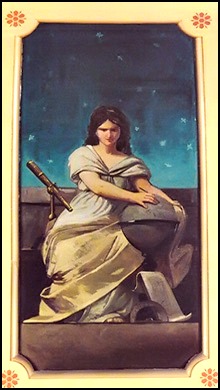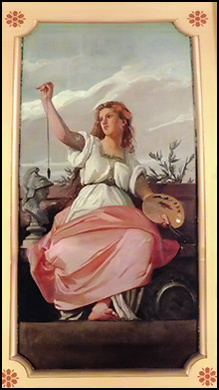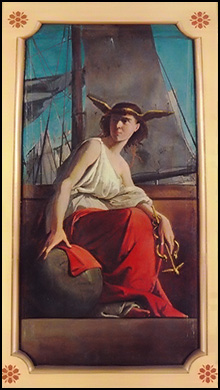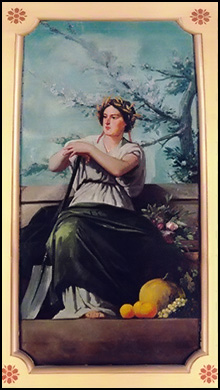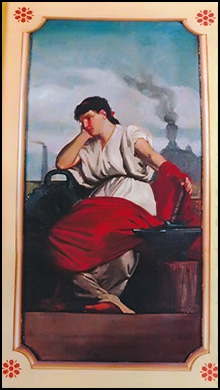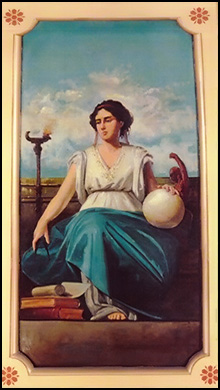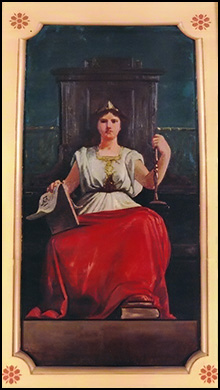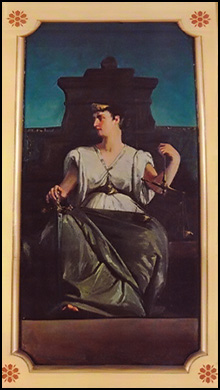

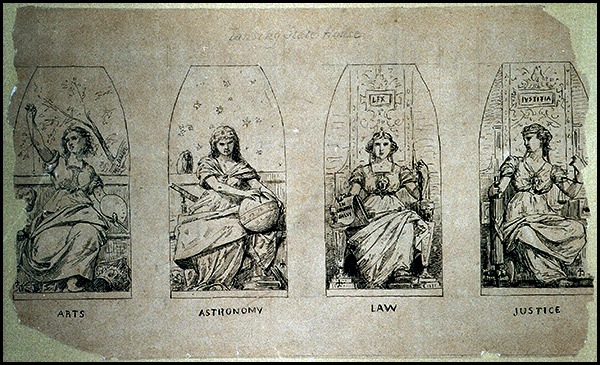
In 1886 Juglaris had an opportunity to move beyond small friezes to display the magnitude of his gifts as a muralist. Perhaps thanks to stained glass manufacturer Donald MacDonald, who had already completed work at a Detroit church attended by one of Michigan’s governors, Juglaris was alerted to a competition for the decoration of the rotunda of the Michigan State Capitol in Lansing. The announced project coincided with planning for Michigan’s celebration of the fiftieth anniversary of its admission to the American Union.
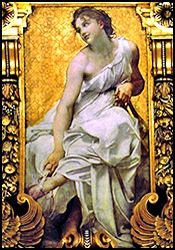
Since figural drawing was Juglaris’s great forte, it was almost inevitable that his Michigan Capitol proposal would be dominated by human figures. However, Juglaris’s choice of subject mater may also have been inspired and influenced by the work of two French artists at the Palais Garnier Opera House where he had recently designed and painted a ceiling all his own—as evidenced by drawings later proudly exhibited at the Boston Art Club.
For the Palais Garnier’s ornate Grand Foyer, the acclaimed Paul Baudry had painted, among other gilded scenes, the nine muses of classical mythology—Calliope, Clio, Euterpe, Melpomene, Terpischore, Erato, Polyhymnia, Urania, and Thalia. Each muse, a daughter of Zeus, was said to be an inspiration for a different art. Baudry’s muses are lithe and elegant—well-suited to the style of late nineteenth-century Belle Epoque Paris. In the Palais Garnier’s auditorium, another artist, Jules-Eugene Lenepveu, completed a ceiling mural entitled Les Muses and Les Heures du Jour et de la Nuit (The Muses and the Hours of Day and Night). The ceiling mural presented a swirl of movement and activity as day swiftly becomes night, only to become day again.
Taking artistic liberty with the mythological traditions of ancient Greece, Juglaris’s own submission to a Lansing committee consisted of eight muses, each representing a field of endeavor important to Michigan’s progress as a state. A preliminary sketch of four of them successively labeled Arts, Astronomy, Law, and Justice survived among the artist’s papers discovered in northern Italy during the late 1990s. However, Juglaris’s eight muses were later adapted to more broadly represent Fine Arts and Architecture, Agriculture, Philosophy, Science, Law and Government, Industry, Commerce, and Education.
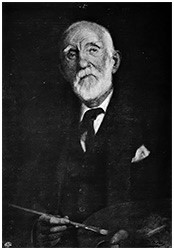
Significantly, Juglaris’s symbolic use of female imagery coincided with nascent and ongoing professional advances by women who refused to be relegated to the domestic spheres of home life. In this vein, while Juglaris’s depiction of a female astronomer among his muses may have been inspired by the trailblazing Maria Mitchell (1818-1889) from Nantucket, Massachusetts, who so capably studied the surfaces of Jupiter and Saturn and even discovered a comet, it was also locally anticipatory, if not a little prophetic. The first half of the ensuing century was to witness at the nearby University of Michigan and its affiliated Detroit and McMath-Hulbert Observatories the emergence of four outstanding women of sky science—the astronomers Harriet Williams Bigelow, Hazel Marie Losh, Agnes Ermina Wells, and Helen Dodson Prince.
Similarly, other Michigan women stand out for unforgettable “firsts” in those further fields that Juglaris sought to celebrate with his muses. In a state that could rightfully claim to be the final home for the abolitionist and women’s rights activist Sojourner Truth (1797-1883), Sarah Killgore Wertman and Elizabeth Eaglesfield had already been admitted to the Michigan Bar for legal practice. Moreover, Eaglesfield not only ended up as a Grand Rapids real estate mogul but also a leading maritime attorney, a Great Lakes ship captain (S.S. Golden Girl), and the owner of a fleet of five freighters transporting Michigan fruit and produce. In turn, now counted among “America’s First Women Philosophers,” Marietta Kies and Eliza Read Sunderland were soon to receive philosophy doctorates from the University of Michigan in 1891 and 1892, enjoying prominent careers as authors and educators. Meanwhile, committed to the realms of the fine and applied arts, ceramicist Mary Chase Perry Stratton pursued her own studies and opened the famed Pewabic Pottery Studio in Detroit in 1903. She was followed by Emily Helen Butterfield who, just four years later, received her license as Michigan’s first woman architect.
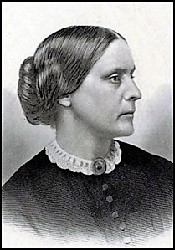
Of course, providing early encouragement and moral support for most, if not all, of these women was the politically active Michigan Equal Suffrage Association (MESA). At almost the same time that bids were being solicited for the Capitol rotunda decoration the organization was petitioning the Michigan Legislature to secure municipal voting rights for women. MESA’s enthusiastic members were also getting poised to host their third annual convention in borrowed upstairs rooms of the Michigan Capitol with the House of Representatives chamber serving as their auditorium. Scheduled for mid-January 1887, the convention would showcase as keynote speakers Michigan-born Anna Howard Shaw, a newly minted physician and ordained clergywoman, and the even more formidable Susan B. Anthony.
Amid this ferment and agitation on behalf of women’s rights and opportunities, Juglaris’s proposal for the Michigan Capitol rotunda featuring the eight muses won, trumping a much more elaborate decorative scheme submitted with considerable fanfare by one of Detroit’s foremost artists, Robert Hopkin. Although very few American artists had experience with mural work, Hopkin was exceptional: previous mural projects to his credit at the Canadian Parliament Building in Ottawa and the New Orleans Cottage Exchange had from start to finish made him Juglaris’s most credible and challenging competitor. Yet neither Hopkin’s experience nor his Michigan pedigree could turn the tide for him over and against Juglaris’s conspicuous talents, iconic approach, and presumably well-priced bid.
Juglaris painted his eight commissioned muses in his Boston studio during spring 1886, working rapidly in the face of a deadline. When finished, the canvasses for all eight muses were rolled up and shipped to Michigan for installation in the Capitol rotunda.

Juglaris’s contract came under the auspices of William Wright of Detroit, whose firm was responsible for the overall decorative painting of the Capitol. Although a Lansing newspaper announced that the rotunda commission had been awarded to “the best artist of his kind,” Juglaris was never publicly acknowledged. In fact, while Juglaris was still working on the Michigan Capitol project the entire nation was being swept by labor turmoil and worker demands for higher wages and a shorter working day. Labor historians remember this tumult as “The Great Upheaval.” In this politically-charged atmosphere, Chicago’s so-called “Haymarket Square Riot” broke out on May 4, 1886. Breaking up a demonstration by foreign-born anarchists, seven policemen were killed by a blast of dynamite. Another sixty policemen were wounded. National hysteria ensued with fears openly expressed about the patriotism and loyalty of immigrants. The following winter, amid lobbying by native-born painters, the Michigan legislature passed a law prohibiting non-citizens, unless they had professed an intention to become an American citizen, from working on government buildings. This was part of a national trend. In Michigan, it remained impolitic to mention Juglaris, who had retained his Italian citizenship. Consequently, his name was lost for over a century.
In time Juglaris’s work was mistakenly attributed to a Michigan-born artist, Lewis Ives. Juglaris may have unwittingly contributed to this conspiracy of silence. Rather than signing the Capitol muses with his full surname, he marked them with an enigmatic “TJ” monogram which later generations had difficulty deciphering. Juglaris’s only consolation—noted in his memoir—was that he was paid well and on time for his Michigan Capitol commission.
